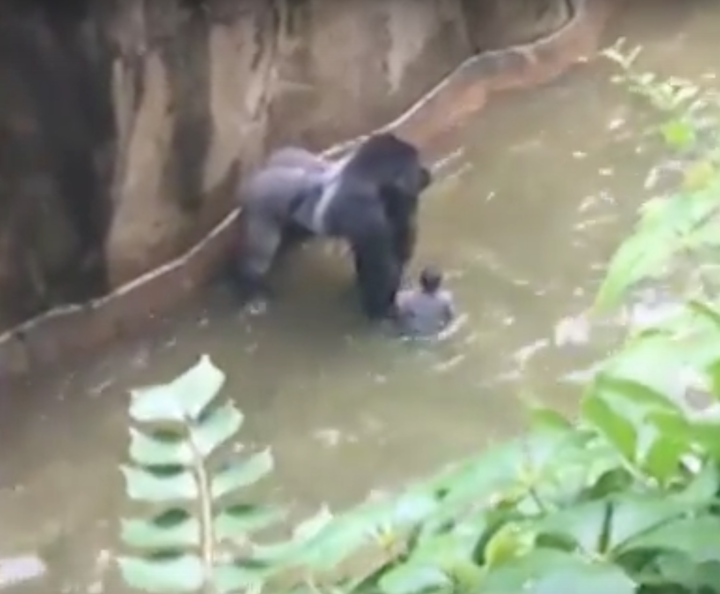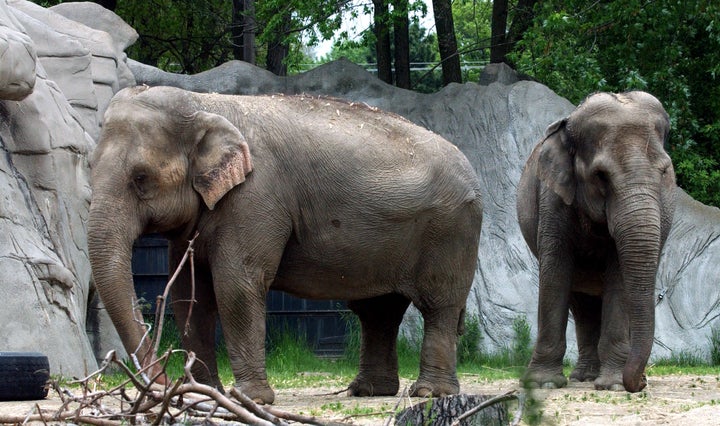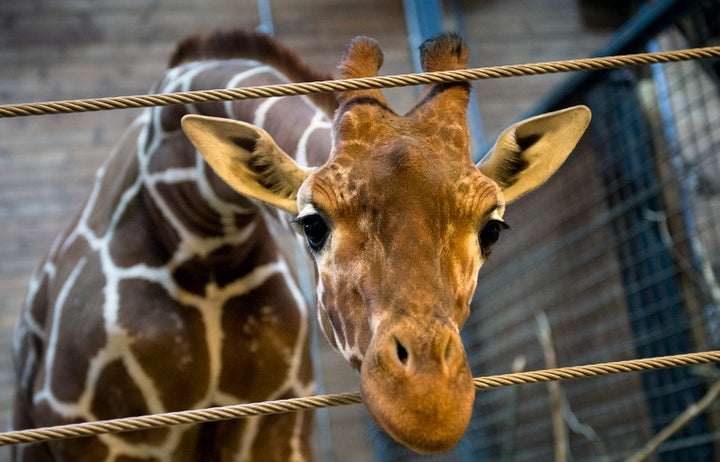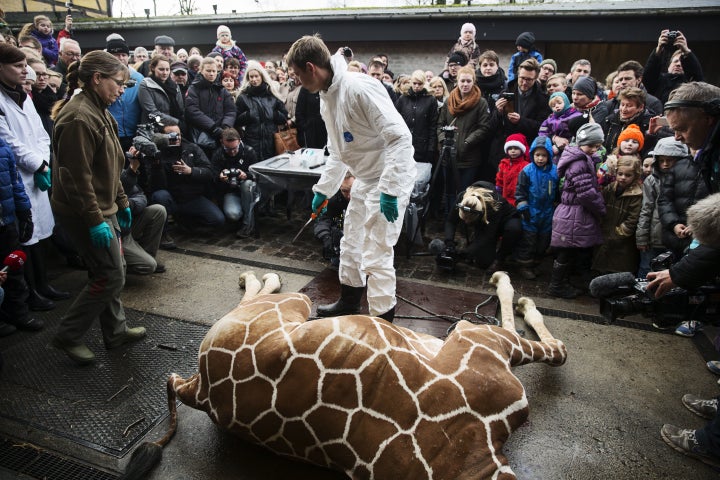Last weekend, a 17-year-old western lowland gorilla called Harambe was shot dead at a zoo in the US after a child entered his enclosure.
The killing of the critically-endangered animal, not by threats such as poachers or habitat loss, but at the hands of armed zoo staff, sparked international outrage.
Some blamed the parents, others Cincinnati Zoo. Police are currently investigating the circumstances leading up to the animal's death.
But the shooting of Harambe, an animal bred in captivity that never made it to the wild, sparked an ethical debate around the function of zoos.
Zoos have evolved from being solely for entertainment to organisations that promote conservation and education since their establishment in the nineteenth century.

Yet as the Harambe case proves, keeping animals in captivity brings with it dilemmas, with animal welfare campaigners continuing to raise serious concerns about the impact zoos have on the wellbeing of animals.
The End Of The Zoo 'Experiment'?
Will Travers, founder and president of the Born Free Foundation, said in a blog on The Huffington Post UK this week, that it is time for a long-overdue debate about our relationship with wild animals and the natural world.
Travers wrote: "We must determine whether the zoo experiment, the public display of exotic animals to an increasingly urbanised human society, has any further role to play or whether, in a world that by the end of this century will be jammed-packed with 11 billion human beings, we can make space for wildlife in the wild."
Dr Ros Clubb, senior scientific officer at the RSPCA, coauthored a report looking at the welfare of zoo elephants in Europe. She and her colleague Georgia Mason were "really shocked" at just how bad problems were in zoos, particularly around the training of elephants and the effect captivity has on their life span.
Captive-born female Asian elephants live 19 years on average. This is less than half the lifespan of working logging elephants who haul timber in the Burmese forests, who can live up to 40 years of age.
"Historically, there has been a lack of willingness to admit that there are serious problems on the part of zoos because that’s admitting failure," Dr Clubb tells HuffPost UK.
But times have changed.
Detroit Zoo is a facility that has been hailed by animal welfare experts for prioritising the wellbeing of animals.
In April 2005, the zoo broke with tradition and decided not to keep elephants any longer because it could not give them the space and environment they needed. The elephants were moved to a sanctuary.
Ron Kagan, director of the zoo, told BBC's Horizon that a "good zoo must have animals it knows can thrive", rather than trying to have the largest number of species as possible.
Dr Clubb agrees that one of the main things that zoos can do to improve animal welfare is to limit their number of species, although collaboration between zoos is also important.
Zoos In A 'Difficult Position'
She explains that few, if any zoos, want male calves because of the expense to keep them. A solution could be a volunteer facility that simply specialises in keeping bull elephants in a herd.
"They have to manage their collection in their space and take responsibility for all the animals that they’re producing," she adds.
"Zoos have to be honest about what they are there for."

But zoos are in a "difficult position", Dr Clubb admits, having transformed from "entertainment facilities" into having a specific role in conservation, education and research - although there are differing opinions as to just how well they are fulfilling these roles.
Professor Robert Young, a specialist in animal behaviour at the University of Salford, is one who believes that seeing animals in a zoo enables people to care about them more, giving them an "emotional response".
"People go to the zoo for a good day out but at the same time they are educated," Professor Young tells HuffPost UK.
The lecturer says that zoos are the most visited institution in the world, with 10% of the global population - 700 million people - visiting zoos every year.
Furthermore, Professor Young believes that compared to museums, which are more likely to attract the middle class, zoos are visited by all social classes.
"Zoos go across all social boundaries, so they get into everybody's life, so zoos have this massive potential for causing behavioural change."
But the RSPCA's Ros Clubb is sceptical about the educational impact a zoo can actually have on visitors.
"In terms of the day-to-day visitors the evidence is that the vast majority don’t get educated and don’t have any change in their behavior.
“Most people just want a nice day out,” Dr Clubb says.
“If you’re trying to educate people about wild animals, then I wouldn’t take them to a zoo”
- Dr Ros Clubb, RSPCA
She says that formal visits, where visitors are taken around by a guide, might have a stronger educational impact, but overall Dr Clubb believes people learn more watching wildlife documentaries television than visiting a zoo.
"If you’re trying to educate people about wild animals then I wouldn’t take them to a zoo,” Dr Clubb says.
Virtual zoos and interactive technology is a promising prospect for learning about wildlife in the future, Dr Clubb adds.
Breeding Controversy Or Insurance Policy?
The question over how well zoos are fulfilling their role in conservation is another issue that its hotly contested.
Dr Clubb explains that there needs to be a greater level of scrutiny over how captive animals, such as elephants, contribute to conservation.
"They are never going to go back to the wild, ever," she says.
"[Zoos] need to import elephants from the wild to keep the captive population going, and we know that people generally don’t learn about the species or the animal from just seeing them in the zoo."

And with breeding programmes, there also comes 'excess' animals.
In February 2014, Marius, a young male giraffe unsuitable for breeding, was shot, dissected in front of a large crowd and fed to lions at Copenhagen Zoo.
The move sparked international outrage, with thousands of people signing a petition calling for the young animal to be saved.
But Marius is just one of thousands to be culled. It is estimated that between 3,000 and 5,000 healthy surplus animals are killed in European zoos every year, the BBC's Horizon programme reported.
Born Free's Travers believes that zoos do not deliver a conservation dividend, nor are they "providing the kind of educational resources that will inspire the naturalists of the future".
But the University of Salford's Professor Young describes zoo breeding as a valuable backup.
"The captive breeding is a bit like an insurance policy," he says.
"You buy insurance for your car hoping that we will never need it, so we captively breed orangutans and species like that, hoping we are not going to destroy their environment so much that none can survive in the wild.

"But if we do, if our species is so stupid as to do something like that, then we do have animals that could eventually be released into the wild when we recover the habitats," Prof Young says.
Ethical Dilemmas... That’s Just The Way It Is
Dr Clubb says for those concerned about animal welfare, there are danger signs to look out for.
Repetitive actions which appear to have no obvious goal or function are indicative of abnormal behaviour. This may include head swaying, rocking and pacing, she says.
Looking at the quality of enclosures is also important, questioning what is actually available for the animals.
Dr Clubb adds: "I’ve seen enclosures that are stunning but when you look closely there are hot wires around the big trees so the animal can’t get to them. It protects the trees. It’s just decoration for the people to make it look more natural."
Hiding space for animals is also essential, yet this can present a dilemma for zoos as visitors go to their facility in order to see the animals. Dr Clubb believes that it is important "to look behind the façade" in order to establish how an animal is in a place for them to be seen.
Professor Young is adamant that that not all animals suffer in zoos and believes it is "definitely" ethical to visit one, but experts ultimately disagree.
Animals such as polar bears suffer greatly in captivity when they are not given the room they require to move. Disturbing behaviour has been documented, showing polar bears rocking back and forth. In the wild these animals can swim hundreds of miles, so they suffer particularly badly in captivity.
This revelation has meant that most zoos in the UK have phased out polar bears.
"I have never been to a zoo where there are no problems," Dr Clubb says.
"I think every zoo I have been to, as soon as you bring a wild animal into captivity, there are ethical dilemmas and that’s just the way it is."
